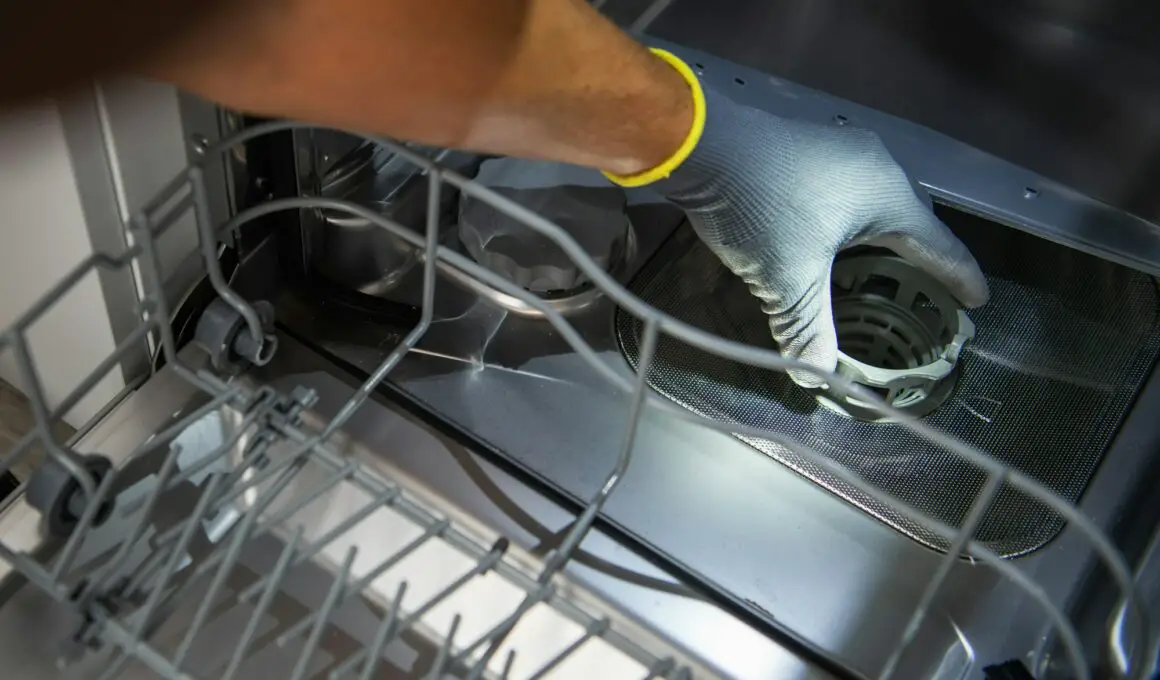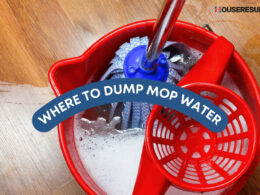Table of Contents Show
Whether you’re a homeowner looking to ensure your appliance runs smoothly or you’re simply tackling spring cleaning, this step-by-step guide will walk you through everything you need to keep your dishwasher in top shape. Cleaning your dishwasher is crucial not only for hygiene but also for efficiency and longevity.
Over time, leftover food particles and mineral buildup can clog your dishwasher’s system, leading to reduced performance and potential repairs. Today, I’ll show you how to effectively clean each component, ensuring your dishwasher continues to operate at its best.
How to Clean a Dishwasher
Join me as we enhance your kitchen’s hygiene and your dishwasher’s functionality, ensuring spotless dishes with every cycle.
1. Preparation and Safety
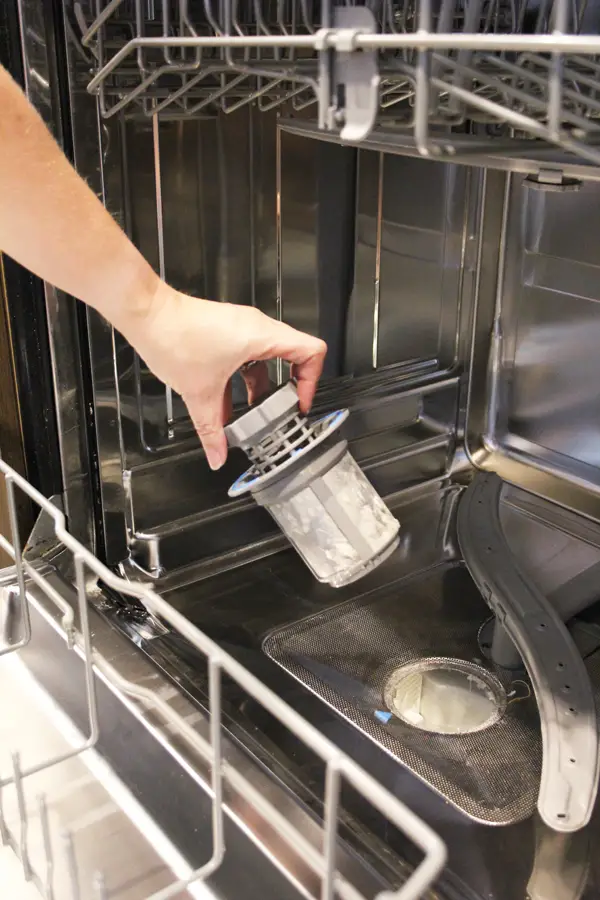
Before diving into the cleaning process, it’s important to gather all necessary tools and cleaning agents and to understand the safety precautions to ensure a smooth and safe experience. Here’s how you can prepare:
What You’ll Need (Tools and Cleaning Agents)
- Soft cloths or sponges: These are gentle on your dishwasher’s interior and perfect for wiping down surfaces.
- A toothbrush or small brush: Useful for scrubbing hard-to-reach areas and removing debris from the filter and spray arms.
- Dish soap: A mild dish detergent can help in removing grease and build-up.
- White vinegar: Excellent for dissolving grime and enhancing shine without harsh chemicals.
- Baking soda: Great for removing odors and stubborn stains inside the dishwasher.
- Rubber gloves: To protect your hands from dirt and cleaning solutions.
- Screwdriver: Needed if you have to remove parts like the spray arms for deep cleaning.
Safety Precautions Before Starting
- Unplug or turn off the dishwasher: Ensure the appliance is not powered to avoid any electrical hazards while you’re working inside it.
- Check the manufacturer’s guide: Some dishwashers may have specific instructions or warnings about cleaning products or methods to avoid.
- Wear protective gloves: Cleaning agents and even residual detergent can be harsh on the skin; gloves will protect your hands.
- Ensure good ventilation: If you’re using stronger cleaners or if you’re sensitive to smells, make sure the area is well-ventilated.
2. Cleaning the Dishwasher Filter

One of the most crucial components to clean in your dishwasher is the filter. A clean filter ensures efficient operation and prevents food particles from recirculating onto your dishes. Here’s how you can locate, clean, and maintain your dishwasher filter:
Locating the Filter
- Find your manual: Start by checking your dishwasher’s user manual for specific instructions on locating the filter. This can vary between models.
- Typical locations: In most dishwashers, the filter is located at the bottom of the machine, under the lower spray arm. It may be a cylindrical or flat screen.
- Visual inspection: Open the dishwasher and remove the bottom dish rack to access the filter area. Look for a cylindrical or flat mesh screen. This is your filter assembly.
Step-by-Step Instructions on How to Remove and Clean the Filter
- Remove the filter: Depending on your model, this might involve unscrewing or simply twisting the filter counterclockwise. Handle gently to avoid damaging it.
- Rinse the filter: Hold the filter under running warm water to wash away most of the debris.
- Scrub the filter: Using a soft brush or toothbrush, gently scrub the mesh and plastic frame to remove any trapped particles and grime. If it’s very dirty, soak it in a solution of warm water and mild detergent for about 10 minutes before scrubbing.
- Rinse again: After scrubbing, rinse the filter thoroughly under running water until it’s clean.
- Dry and reinstall: Shake off excess water and reinstall the filter in your dishwasher. Ensure it’s correctly in place and secured, as an improperly installed filter can affect the dishwasher’s performance.
Tips for Maintaining the Filter
- Regular checks: Inspect and rinse your dishwasher filter every few weeks or more frequently if you notice the dishwasher is not performing as well.
- Avoid hard cleaners: Stick to mild detergents and avoid harsh chemicals that could damage the filter.
- Handle with care: When cleaning the filter, be gentle to avoid any tears or damage to the mesh that could compromise its effectiveness.
3. Cleaning the Spray Arms
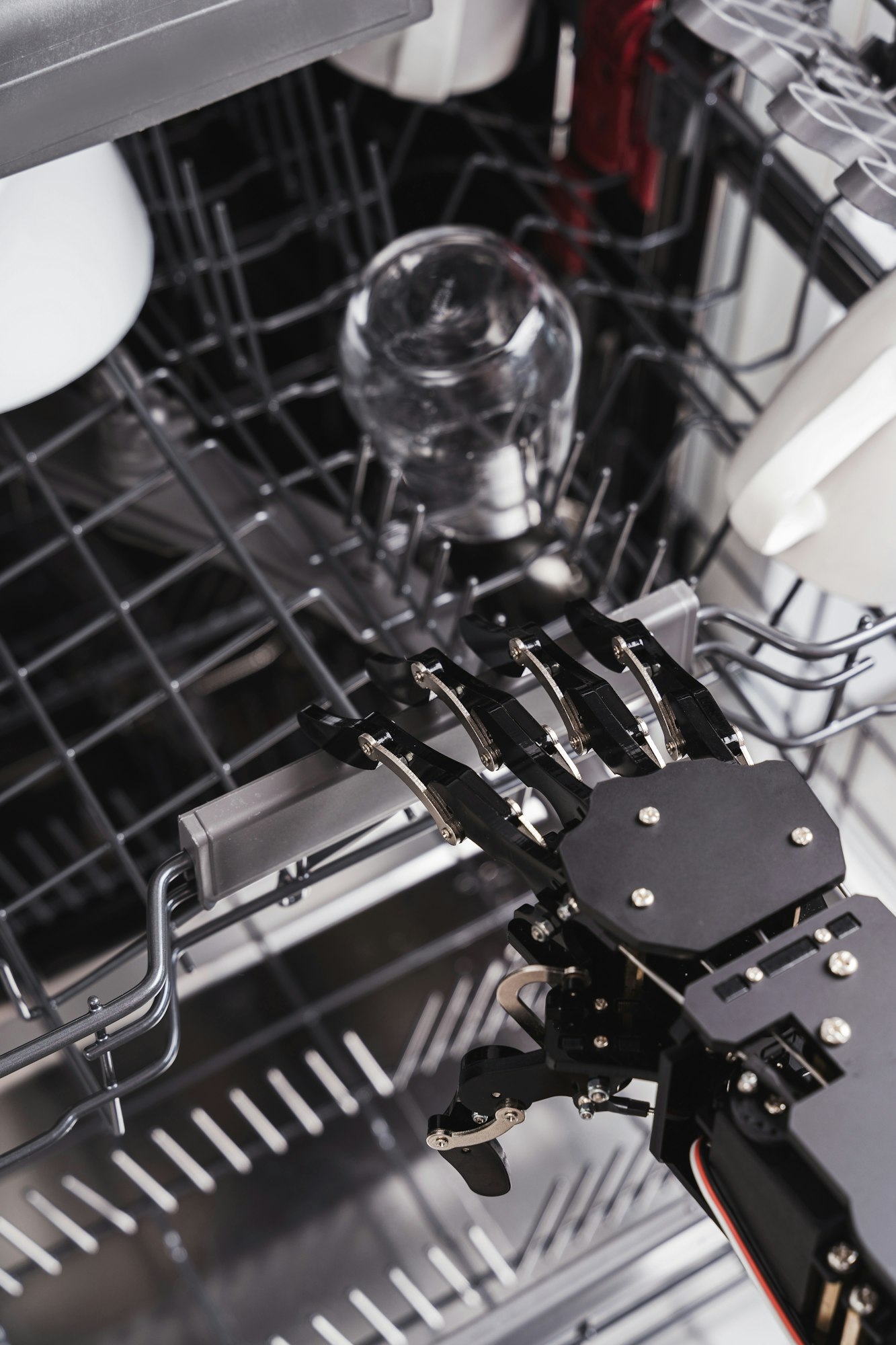
The spray arms in your dishwasher play a critical role in ensuring your dishes come out clean. Over time, these arms can get clogged with food particles and mineral deposits, reducing their effectiveness. Here’s how to access, clean, and properly reattach the spray arms to maintain optimal performance.
How to Access and Remove Spray Arms
- Turn off the dishwasher: Ensure the dishwasher is turned off and disconnected from power for safety.
- Remove the bottom rack: Slide out the bottom rack to expose the lower spray arm.
- Detach the spray arms: Depending on your model, the lower spray arm may either snap off or require unscrewing. Use a screwdriver if necessary. For the upper spray arm, you may need to unscrew it from the bottom of the upper dish rack.
Detailed Guide on Cleaning and Unclogging Spray Holes
- Inspect the spray arms: Look closely at each spray arm and identify any holes that are blocked by debris.
- Rinse under water: Hold the spray arms under warm running water to dislodge loose particles. This can help to clear out some of the easier blockages.
- Use a toothpick or needle: For tougher clogs in the spray holes, gently use a toothpick or a small needle to remove the debris. Be careful not to scratch or enlarge the holes.
- Soak if necessary: If the spray arms are heavily coated with mineral deposits, soak them in white vinegar for a few hours. This will help dissolve the calcium and lime build-up.
- Rinse and dry: After unclogging and soaking, rinse the spray arms thoroughly under running water and dry them with a soft cloth.
Reattaching the Spray Arms Properly
- Check for damage: Before reattaching, inspect the spray arms for any cracks or damage. Replace them if necessary to avoid leaks or poor performance.
- Reinstall the spray arms: Attach the lower spray arm back into place, ensuring it locks securely or is screwed in tightly. For the upper spray arm, align it correctly under the upper dish rack and screw it in place. Ensure it spins freely, which indicates it’s not obstructed and is properly installed.
- Test the dishwasher: Run the dishwasher on a short cycle while empty to ensure everything is working correctly and the spray arms are functioning properly.
4. Cleaning the Interior of the Dishwasher
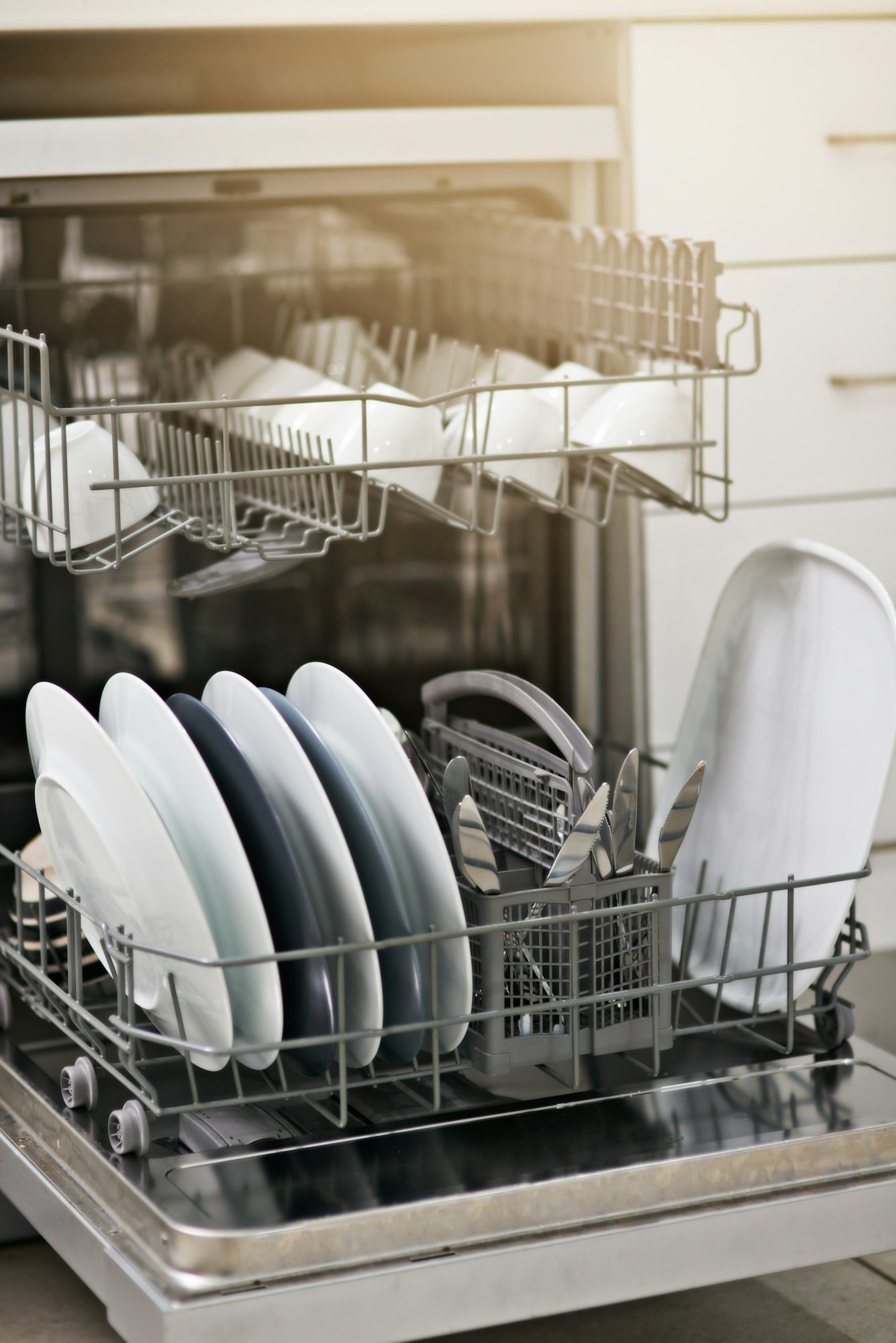
Keeping the interior of your dishwasher clean not only improves its performance but also extends its lifespan and ensures it operates at peak efficiency. Here’s how to clean the racks, silverware basket, and inner surfaces effectively.
Cleaning the Racks and Silverware Basket
- Remove the racks and basket: Take out the dishwasher racks and the silverware basket to make them easier to clean.
- Rinse with water: Use a sink sprayer or hose to rinse these components, removing loose debris and food particles.
- Scrub with a soft brush: Using a soft brush and a mild detergent, scrub the racks and basket to remove any stuck-on grime and buildup.
- Check for and remove rust: If you notice any signs of rust on the wire racks, use a rust remover or sand lightly with sandpaper and apply a rust-proofing agent.
- Dry and replace: Dry the racks and silverware basket with a towel or let them air dry before placing them back in the dishwasher.
Wiping Down the Interior Walls and Door
- Mix your cleaning solution: Prepare a solution of warm water and a mild detergent, or use a mixture of white vinegar and water for a natural cleaning option.
- Wipe down surfaces: Dip a soft cloth or sponge in the solution and wipe down the interior walls, the floor, and the door of the dishwasher. Pay special attention to the area around the door seal, as it can accumulate residues and mold.
- Clean the detergent dispenser: Wipe the detergent dispenser compartment with a damp cloth to remove detergent residues and buildup.
Recommended Products and Natural Cleaners
- Commercial dishwasher cleaners: These are formulated specifically for dishwashers and can help remove grease and limescale effectively.
- White vinegar: An excellent natural descaler, it can be used to clean and deodorize the dishwasher. Fill a dishwasher-safe cup with white vinegar, place it on the top rack, and run a hot-water cycle with the dishwasher empty.
- Baking soda: After the vinegar cycle, sprinkle a cup of baking soda across the bottom of the dishwasher and run a short, hot-water cycle. This will help remove any lingering odors and brighten the interior.
- Lemon juice: As an alternative to vinegar, lemon juice can be used for its natural acidic properties, which help break down grease and freshen the dishwasher.
5. External Cleaning and Maintenance

Maintaining the external components of your dishwasher is just as important as the internal ones to ensure it operates efficiently and remains a visually appealing part of your kitchen. Here’s how to keep the exterior clean and conduct regular maintenance checks.
Cleaning the Dishwasher’s Exterior and Control Panel
- Determine the finish: If your dishwasher has a stainless steel exterior, use a cleaner specifically designed for stainless steel to avoid streaks and damage. For other finishes, mild dish soap and water will suffice.
- Wipe down the exterior: Using a soft cloth, wipe the exterior of the dishwasher. For stainless steel, make sure to wipe in the direction of the grain to prevent scratches.
- Clean the control panel: Use a slightly damp cloth to wipe down the control panel. Be gentle and avoid using spray cleaners directly on the panel to prevent moisture from entering the controls.
Checking and Cleaning the Dishwasher’s Seals
- Inspect the seals: Regularly check the rubber seals around the dishwasher door for cracks, debris, or signs of wear. These seals are crucial for preventing leaks.
- Clean the seals: Use a damp cloth to gently wipe down the seals, removing any food particles or residues that might have accumulated. This not only helps maintain the seal but also prevents mold and odors from forming.
- Treat with vinegar: If you notice mildew or mold on the seals, apply white vinegar with a toothbrush to scrub these areas gently, then wipe clean with a damp cloth.
Monthly Maintenance Tips to Prevent Issues
- Run a cleaning cycle: Once a month, run an empty cycle with a dishwasher cleaner or white vinegar to deep clean the interior and remove any limescale or grease buildup.
- Check and clean the filters and spray arms: As part of your monthly maintenance, ensure the filter and spray arms are clean and clear of debris to maintain optimal performance.
- Keep the drains clear: Regularly check and clean the area around the dishwasher drain to prevent clogs. Remove any large food particles or debris that might cause blockages.
- Inspect hoses and connections: Check the water inlet and drainage hoses for kinks, leaks, or signs of wear. Replace if necessary to prevent water damage or flooding.
- Keep the dishwasher balanced: Ensure your dishwasher is level to prevent undue stress on components and to ensure it operates correctly.
6. Troubleshooting Common Issues

Even with regular maintenance, dishwashers can encounter problems that affect their efficiency and functionality. Knowing how to address common issues can save you time and potentially costly repairs. Here’s how to troubleshoot typical dishwasher problems related to cleanliness and understand when it’s time to call in a professional.
Addressing Common Dishwasher Problems Related to Cleanliness
Dishes not coming out clean
- Check the spray arms: Ensure they are not blocked with debris. Clean as necessary to allow free movement and water flow.
- Examine the filter: A clogged filter can restrict water flow and decrease cleaning efficiency. Clean the filter thoroughly according to the instructions in Section 2.
- Use fresh detergent: Old or poor-quality detergent can result in poorly cleaned dishes. Always use a high-quality detergent and consider using a rinse aid for better drying and spot reduction.
Water not draining properly
- Inspect the drain hose: Ensure it isn’t kinked or blocked. Clean any debris from the hose or the air gap, if applicable.
- Check the drain pump: Access the drain pump according to your manufacturer’s manual and clear any obstructions.
White film on dishes
- Soften your water: Hard water can leave a white residue. Use a water softener or switch to a detergent that is designed for hard water.
- Adjust the amount of detergent: Too much detergent with soft water can also cause filming. Adjust the detergent amount based on the water hardness level.
Unpleasant odor
- Clean regularly: Regular cleaning of the interior, filter, and spray arms can prevent odor buildup.
- Run hot water cycles: Occasionally, run a hot water cycle with vinegar to neutralize odors and clear out old food particles.
When to Call a Professional
- Persistent problems: If issues like poor cleaning quality or drainage problems persist despite troubleshooting, there may be a deeper mechanical or electrical issue.
- Water leaks: If you notice water leaking from the dishwasher, it could be due to a faulty seal, hose, or pump, which might require professional repair.
- Electrical issues: Problems like the dishwasher not turning on, unusual noises during operation, or electronic malfunctions should be handled by a professional to avoid safety risks.
Knowing when to handle a problem yourself and when to call a professional is crucial for maintaining your dishwasher’s longevity and ensuring safe operation. Regular troubleshooting and maintenance can help you avoid many common issues, but recognizing the signs that professional help is needed will prevent larger problems down the road.






